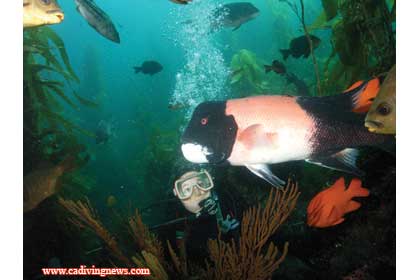You can be a good dive buddy in many ways, but there is nothing more precise than being the buddy of a photographer. It is essential that you plan your dive and know exactly your objective. Photographers are tricky beings and you need to stay out of their way when you need to, and help them create incredible photographs when they need you.
Before we discuss anything, I want to remind you about buoyancy. Obviously, as a diver you will better enjoy any underwater activity with good buoyancy control, but it is even more important as an underwater model to have exact buoyancy. Fine control is extremely important. You don’t want to kick up any silt and be guilty of making the photo unusable because of too much backscatter. But even more important is using your buoyancy control to carefully maneuver yourself into a shot next to marine life. Subtle movements are important not to scare away that fish or mammal. In addition, I have found that subtle hand movements will keep me in the frame the way the photographer wants me to stay without kicking my fins. Natural water movements will move you back and forth in the water column or over the reef, and by using your hands like little fins you can keep the shot consistent.
As an underwater model you need to think of the world as backward. Get in the habit of seeing the underwater scene as it would appear through the camera, but from your perspective. It will allow you to assist in the scene set-up. Be aware of how that gorgonian stand looks, is it sparse on one side and lush and full on the other? Move your body so the camera sees the lush side. As you are being photographed with that garibaldi hovering over the reef and you see a sea star, move your body so the sea star, garibaldi and you are all included in the photo.
As you are being aware of how the photo will look, be also aware of potential photo opportunities as you swim over the reef or posing for photos. Work as a team to spot that perfect scenario. Many times I have sat perfectly still near that lobster while the photographer adjusted his strobes, only to spot a feeding abalone out of the corner of my eye tucked under a rock shelf a few feet from me. As soon as the lobster photo was done, we were able to move on to the next subject ready and waiting to pose with me.
Body posture is extremely important. You want to look natural. You want to look like a diver enjoying the underwater world. You do not want to appear like a model… no extreme angles. It is unnatural to be swimming along and to crane your neck around to look almost behind you to see marine life.
You can’t always have control over what color your gear is, but keep in it mind when making that purchase, that a bright orange snorkel may not look so great with an aqua mask. Fluorescent yellow hose protectors detract from any photo. Try to stay natural or at least not detracting in your color choices with blue or black. If possible try to be consistent with your gear colors.
You can add a diver’s perspective to macro photos by being up close and personal with the marine life, especially invertebrates. If you are inches away from the subject material, you need to give the viewer the impression you are intently looking at the subject. But, you don’t want to look cross-eyed. One trick to make it appear that your eyes are on the subject is to “look through” the subject and into the camera lens. You are essentially throwing your eyes out of focus on the subject. It very much gives the impression you are gazing intently on that little critter, but your eyes stay straight.
When shooting with your photographer buddy, you will want them to get the whole picture. Be aware of why and what is in the photo with you. Are you looking at a school of fish surrounded by kelp? Are you swimming through a cave looking at the gorgonian growing down from the ceiling?
Keep your body as natural as possible. No arm flailing or widespread legs. If it appears you are swimming through a cave, don’t let your fins come in contact with the walls; it takes away the whole illusion of the “swimming” process.
If you are swimming through that kelp bed with fish in the photo or a wall at your side or anything else that makes that shot beautiful, focus on something. Just looking into the camera or off to the side into nothingness is quite honestly boring. You want to bring the viewer into the world with you. It is not a time to take your regulator out of your mouth and smile intently into the camera.










